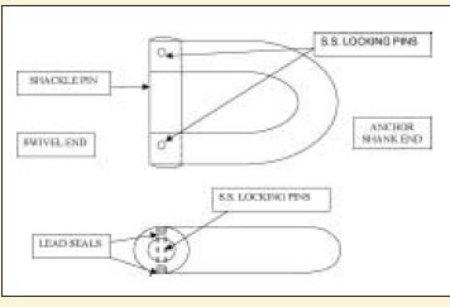200714 Loose anchor shackle pin
Arriving at the previously notified ETA at a major port soon after sundown, our large container ship was told by port control that, due to operational delays on another vessel occupying our berth, our inward harbour-cum-berthing pilot had been postponed by about four hours. Having already entered the outer approaches to the port, it was not advisable to drift or cruise in a highly congested area so I decided to anchor the ship in the planned contingency anchorage before the pilot boarding area. Speed was further reduced to minimum steerageway.
The anchor party, comprising the chief officer, the bosun and a seaman, proceeded forward to prepare the anchors. The port anchor was engaged in gear, the brakes opened and the anchor walked out under power to the intended 'cock-bill' position above the water. To our good fortune, my diligent chief officer was just able to see in the gathering darkness that the pin of the port anchor 'D' shackle connecting the shank to the swivel was almost out of the shackle's lug. He promptly reported it to me and I immediately ordered him to secure the anchor at that position. After a more detailed study with the aid of additional portable lighting, the chief officer rightly relayed his fears that the pin was so far out of the shackle that the anchor was being held by only the edge of it. Any vibration or motion might dislodge the pin and result in the loss of the anchor.
By this time, the ship was just about half a mile away from the intended anchor position. Taking rapid stock of the situation, I ordered the anchoring team to first inspect the 'D' shackle and cable of the starboard anchor. After all was confirmed to be in good order, I instructed them to carefully walk it out to above the water.
The headway was also steadily coming off the ship, such that under the prevailing conditions it was just sufficient to reach the planned anchoring spot. It was also possible to avoid an astern engine movement for fear that the hull vibrations might shake off the loose pin. With good coordination between the bridge and anchoring teams, the starboard anchor was smoothly walked out all the way to the bottom and the ship brought up with judicious use of the windlass brake.
The port was informed of the situation and the agents were advised to arrange for a barge to reconnect the anchor in stream. The barge and a workshop team duly arrived and with the barge moored about four metres under the delicately suspended anchor, and with all personnel stationed clear, the anchor was successfully and gently lowered onto the barge. As soon as the weight was off the shackle, the shackle pin dropped off harmlessly on to the barge's tanktop and the swivel swung free. It was observed that the stainless steel locking pins of the 'D' shackle pin were missing.
A spare anchor 'D' shackle was lowered into the barge by our chief officer and the efficient barge crew quickly reconnected the anchor to the cable and packed the locking pin hole with lead from both ends.
Root cause/contributory factors
At the recent drydocking, the 'D' shackle locking pins had not been properly sealed with lead, and had subsequently wasted away;
In its normal sea stowage position inside the hawse pipe, the 'D' shackle is not easily seen.
Editor's note: Officers and ratings should be trained in essential inspection practices when involved in anchor work. This includes observing and reporting the condition of all moving parts, confirming the proper condition of cables and fittings, detection of twists in the cables, and cracks in stud link welds. The diligence of this chief officer prevented the loss of the anchor, or worse.
Spile and other 'locking' pins that hold Kenter-type joining shackles together and secure the pin of the 'D' shackles should be sighted at every opportunity. Missing or loose lead plugs must be restored to seal the holes efficiently. Lead may be worked in with a hammer but in the case of large diameter cables, molten lead must be poured into the holes using a blowtorch.
The importance of accurate communications between the anchoring and bridge teams is well illustrated by this incident.
 Anchor ‘D’ shackle showing locking pins
Anchor ‘D’ shackle showing locking pins
